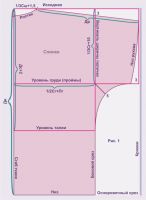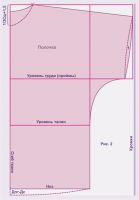 In this article I will tell you how to build a base pattern with a one-piece sleeve and without darts for a kimono dress with your own hands. I will also present several of my ready-made patterns made on this basis and on other kimono base patterns.
In this article I will tell you how to build a base pattern with a one-piece sleeve and without darts for a kimono dress with your own hands. I will also present several of my ready-made patterns made on this basis and on other kimono base patterns.
Bases with a one-piece sleeve have many varieties.
This article discusses the simplest of them - "kimono" without darts.
Download ready-made patterns of kimono dresses - bat
This base is recommended for sizes up to size 52 (see Size charts) and for knitwear.
It is well suited for modeling, the simplest examples of which are shown at the end of the article.
Taking measurements for the base of a kimono without darts
Required Measurements: Di, Ds, Dr, Dpt, Ssh, Sg, St, Sat (cm. "Removal of measurements").
Attention : Dr. in this case it is measured from the lateral point of the neck.
: Dr. in this case it is measured from the lateral point of the neck.
The drawing can be done immediately on the fabric (Fig. 1).
We start with the so-called "grid" - the auxiliary lines of the drawing.
One of the fabric sections should be ground and signed as "Bottom".
Up from the bottom line set aside Di and perpendicular to the fold and edges, draw the original line.
Measure down from original
Ds + 2 cm - waist level.
And again from the original down
1/3Cr + 10 cm - chest level (armhole).
From the fold of the fabric at the level of the armhole, measure
wherein Pg should not be less 6 см, and the sum 1/2Sg + Pg should be at least Sat + Fri.
Pb in this case, it may be minimal 2 см.
According to the original from the fold of the fabric, we measure the width of the sprout
1/3Ssh + 1,5cm
and from the obtained point (it is indicated in Fig. 1 by a red cross) along the initial point we set aside Dr.
The depth of the sprout is measured along the fold of the fabric down the original and is equal to
1/3 sprout width.
The points of the germ are connected by a smooth line.
Next, tilt the shoulder section. To do this, measure 3 см down from the original on the vertical that limits the width of the shelf.
Shortening the sleeve 3 см from the side seam.
Bisector from the corner of the armhole - 5 - 7 cm.
We bring out smoothly the bottom of the sleeve and the side seam.
The back is ready.
We cut it out with minimal or no allowances and put it in place of the shelves with a fold on the fold of the fabric (Fig. 2).
The shelf is cut out on the back.
Differences in cuts of the neckline, bottom of the sleeve and bottom of the kimono dress
Download ready-made patterns of kimono dresses
Neck depth
1/3 Ssh + 1,5 cm,
that is, equal to the width of the sprout and neck.
The bottom of the sleeve is concave, not convex.
The bottom of the product is lowered by the difference in measurements dpt и Ds.
The simplest methods of patternless modeling of the basis of "kimono".
Assembly at the bottom of the sleeve (Fig. 3).
The back is cut out at the same time as the shelf, so you have to make a grid for the shelf.
Attention: the original lines of the shelf and back are the same.
In this case, the shoulder seams and the bottom of the sleeve are combined.
In other words, the lateral points of the sprout and the neck are in contact, and there is no lunge between the shoulder sections.
Gathering at the bottom of the sleeve and a fold along the collar (see photo) unite the bottom of the sleeve, but not the shoulder sections (Fig. 4).
The initial lines of the front and back are at a distance of 1 to 3 cm, depending on the width of the processing seam (see also "Machine stitches").
Beginners should take into account one more thing: it is better to mark the contour of the neckline on the fitting (see "What are fittings?").
To put on the product, you will have to make an additional cut along the fold of the fabric or not completely grind the shoulder cut.
For the boat neckline (see photo at the beginning of the article), the shoulder sections are not ground down to the very neck.
In conclusion, it is worth saying that the “boat” can be asymmetrical.
Ready-made patterns of kimono dresses and how to sew with your own hands
Download a ready-made pattern of a kimono dress with pockets
Ready-made dress pattern cut-off kimono with pockets
Download a life-size pattern of a cut-off kimono dress with pockets
Eva Green Bat Dress Pattern
PDF file for downloading and printing do-it-yourself patterns of a dress with a straight silhouette of a bat or Eva Green's kimono in full size for sizes from 40 to 54. The level of complexity of sewing is medium. How to sew, read the instructions.
Download Eva Green's bat dress pattern
A simple ready-made pattern of a kimono dress for full
PDF files for printing patterns of this dress in full size for full size from 52 to 62 and for sizes from 40 to 52. The size is selected according to the volume of the hips. When cutting, be sure to compare the length of the pattern with the desired length of the dress. The style of this dress is suitable for almost all types of figures of any height.






 Join my community on Viber...
Join my community on Viber...











